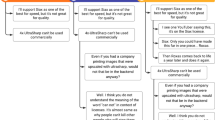Abstract
Nowadays, discussing and commenting interactively on an article in Internet-based social media platforms is pervasive. The topic of a comment/reply in these discussions occasionally shifts, sometimes drastically and abruptly, other times slightly, away from the topic of the article. In this paper, we model and study the topic shift phenomena in article-originated social media comments, and identify quantitatively the effects on topic shifts of comments’ (1) emotion levels (of various emotion dimensions), (2) topic areas, and (3) the structure of the discussion tree. We then propose and evaluate a new approach to measure and visualize named emotion scores of comment sets. We show that, with a better understanding of the topic shift phenomena in comments, personalized automated systems can be built to cater to comment-browsing and comment-viewing needs of different users.















Similar content being viewed by others
References
Alchemy (2015) Sentiment analysis API. http://www.alchemyapi.com/api/sentiment-analysis
Cambria E, Livingstone A, Hussain A (2012) The hourglass of emotions. In: Lecture Notes in Computer Science (including subseries Lecture Notes in Artificial Intelligence and Lecture Notes in Bioinformatics), vol 7403 LNCS, pp 144–157
Disqus: Disqus API (2015). https://disqus.com/api/docs/
FlowingData (2008) How to read and use a box-and-whisker plot. https://flowingdata.com/2008/02/15/how-to-read-and-use-a-box-and-whisker-plot/
Fodor IK (2002) A survey of dimension reduction techniques. Library 18(1):1–18
Freedman DA (1981) Bootstrapping regression models. Ann Stat 9(6):1218–1228
Gross D (2014) Online comments are being phased out. http://www.cnn.com/2014/11/21/tech/web/online-comment-sections/
Hamers L, Hemeryck Y, Herweyers G, Janssen M, Keters H, Rousseau R, Vanhoutte A (1989) Similarity measures in scientometric research: the Jaccard index versus Salton’s cosine formula. Inf Process Manag 25(3):315–318
Hartigan JA, Wong MA (1979) Algorithm AS 136: a \(K\)-means clustering algorithm. J R Stat Soc C 28(1):100–108
Hasan M, Rundensteiner E, Agu, E (2014) EMOTEX: detecting emotions in Twitter messages. In: ASE BIGDATA/SOCIALCOM/CYBERSECURITY conference, pp 27–31
Havasi C, Speer R, Alonso JB (2007) ConceptNet 3: a flexible, multilingual semantic network for common sense knowledge. In: Proceedings of recent advances in natural languges processing 2007, pp 1–7. http://citeseer.ist.psu.edu/viewdoc/summary?doi=10.1.1.115.2844
He D, Göker A, Harper DJ (2002) Combining evidence for automatic Web session identification. Inf Process Manag 38(5):727–742
Kleinberg JM, Kumar R, Raghavan P, Rajagopalan S, Tomkins AS (1999) The Web as a graph: measurements, models, and methods. Computer 1627(2):1–17. http://portal.acm.org/citation.cfm?id=1765751.1765753
Knights D, Mozer MC, Nicolas N (2009) Detecting topic drift with compound topic models. In: ICWSM
Liu Q, Huang H, Feng C (2013) Micro-blog post topic drift detection based on LDA model. pp 106–118
Manning CD, Raghavan P, Schütze H (2008) Introduction to information retrieval, vol 1
Motulsky H (2002) The link between error bars and statistical significance. https://egret.psychol.cam.ac.uk/statistics/local_copies_of_sources_Cardinal_and_Aitken_ANOVA/errorbars.htm. Accessed 13 Nov 2015
Murguia M, Villasenor JL (2003) Estimating the effect of the similarity coefficient and the cluster algorithm on biogeographic classifications. Annales Botanici Fennici 40:415–421. https://www.jstor.org/stable/23726799?seq=1#page_scan_tab_contents
NLP S (2013) Sentiment analysis. http://nlp.stanford.edu/sentiment/
O’Hare N, Davy M, Bermingham A, Ferguson P, Sheridan PP, Gurrin C, Smeaton AF, OHare N (2009) Topic-dependent sentiment analysis of financial blogs. In: International CIKM workshop on topic-sentiment analysis for mass opinion measurement, pp 9–16
Porter M (1980) An algorithm for suffix stripping. Program 14:130–137
Rokach L, Maimon O (2005) Decision tree. Data mining and knowledge discovery handbook, pp pp 165–192. http://www.ise.bgu.ac.il/faculty/liorr/hbchap9.pdf
Russell JA (1980) A circumplex model of affect. J Pers Soc Psychol 39(6):1161–1178. http://psycnet.apa.org/journals/psp/39/6/1161
Salton G, Buckley C (1988) Term-weighting approaches in automatic text retrieval. Inf Process Manag 24(5):513–523
SenticNet SenticNet. http://sentic.net/downloads/
Skuta C, Bartunek P, Svozil D (2014) InCHlib—interactive cluster heatmap for web applications. J Cheminform 6(1):44–52
Smith MS, Ogilvia DM, Stone PJ, Dunphy DC, Hartman JJ (1967) The general inquirer: a computer approach to content analysis. Am Sociol Rev 32. doi:10.2307/2092070
Strapparava C, Valitutti A (2004) WordNet-affect: an affective extension of WordNet. In: Proceedings of the 4th international conference on language resources and evaluation, pp 1083–1086
Topal K, Koyuturk M, Ozsoyoglu G (2016) Emotion and area-driven topic shift analysis in social media discussions. In: 2016 IEEE/ACM international conference on advances in social networks analysis and mining (ASONAM), pp 510–518
Turney PD, Pantel P (2010) From frequency to meaning: vector space models of semantics. J Artif Intell Res 37:141–188
Wall M, Rechtsteiner A, Rocha L (2003) Singular value decomposition and principal component analysis. In: A practical approach to microarray data analysis, pp 91–109
Wiebe JM, Ellen R (2005) Creating subjective and objective sentence classifiers from unannotated texts. Comput Linguist Intell Text Process 3406:486–497
Wilson T, Wiebe J, Hoffman P (2005) Recognizing contextual polarity in phrase level sentiment analysis. Acl 7(5):12–21
XPO6 (209) List of English stop words. http://xpo6.com/list-of-english-stop-words/
Acknowledgements
This research is supported by a MEB scholarship for the first author from the government of Turkey and the US NIH Grant R01HS020919-01.
Author information
Authors and Affiliations
Corresponding author
Rights and permissions
About this article
Cite this article
Topal, K., Koyutürk, M. & Özsoyoğlu, G. Effects of emotion and topic area on topic shifts in social media discussions. Soc. Netw. Anal. Min. 7, 46 (2017). https://doi.org/10.1007/s13278-017-0465-y
Received:
Revised:
Accepted:
Published:
DOI: https://doi.org/10.1007/s13278-017-0465-y




